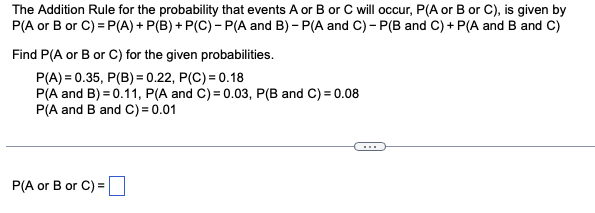The Addition Rule for the probability that events A or B or C will occur, P(A or B or C), is given by P(A or B or C)=P(A) + P(B) + P(C) - P(A and B)- P(A and C) - P(B and C) + P(A and B and C) Find P(A or B or C) for the given probabilities. P(A)=0.35, P(B) = 0.22, P(C) = 0.18 P(A and B)=0.11, P(A and C) = 0.03, P(B and C) = 0.08 P(A and B and C) = 0.01 P(A or B or C) = www
The Addition Rule for the probability that events A or B or C will occur, P(A or B or C), is given by P(A or B or C)=P(A) + P(B) + P(C) - P(A and B)- P(A and C) - P(B and C) + P(A and B and C) Find P(A or B or C) for the given probabilities. P(A)=0.35, P(B) = 0.22, P(C) = 0.18 P(A and B)=0.11, P(A and C) = 0.03, P(B and C) = 0.08 P(A and B and C) = 0.01 P(A or B or C) = www
College Algebra
7th Edition
ISBN:9781305115545
Author:James Stewart, Lothar Redlin, Saleem Watson
Publisher:James Stewart, Lothar Redlin, Saleem Watson
Chapter9: Counting And Probability
Section9.3: Binomial Probability
Problem 2E: If a binomial experiment has probability p success, then the probability of failure is...
Related questions
Question

Transcribed Image Text:The Addition Rule for the probability that events A or B or C will occur, P(A or B or C), is given by
P(A or B or C)=P(A) + P(B) + P(C) - P(A and B)- P(A and C) - P(B and C) + P(A and B and C)
Find P(A or B or C) for the given probabilities.
P(A) = 0.35, P(B) = 0.22, P(C) = 0.18
P(A and B) = 0.11, P(A and C) = 0.03, P(B and C) = 0.08
P(A and B and C) = 0.01
P(A or B or C) =
Expert Solution
This question has been solved!
Explore an expertly crafted, step-by-step solution for a thorough understanding of key concepts.
Step by step
Solved in 2 steps

Recommended textbooks for you

College Algebra
Algebra
ISBN:
9781305115545
Author:
James Stewart, Lothar Redlin, Saleem Watson
Publisher:
Cengage Learning

College Algebra
Algebra
ISBN:
9781305115545
Author:
James Stewart, Lothar Redlin, Saleem Watson
Publisher:
Cengage Learning